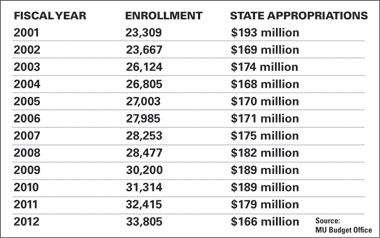
MU has had to do more with less state funding due to higher education budget cuts since 2001.
As MU's student population has risen, state funding to the university has fallen over the past 10 years. From 2001 through fiscal 2012, state funding to MU dropped 14 percent, while student enrollment increased 45 percent, MU budget and enrollment records show.
The contrast between rising student enrollment and state funding cuts came into sharp focus after Gov. Jay Nixon, BA ’78, JD ’81, unveiled on Jan. 17 his agenda to balance Missouri’s budget, which is projected to have a $500 million shortfall for fiscal 2013.
Nixon’s $23 billion proposed agenda includes funding cuts to public colleges and universities of at least 12.5 percent. Funding for four-year higher education schools would be slashed by $99 million. MU’s share of the cut would be about $21 million.
A review of MU enrollment and state appropriations since 2001 shows the university has been educating more students despite cuts to its funding.
In 2001, MU student enrollment was 23,309, and state funding was $193 million. By 2005, the head count had jumped to 27,003, while funding had shriveled to $170 million.

After a modest increase in state funding from 2006 to 2009, funding for the last two fiscal years has fallen from $189 million to $166 million. Meanwhile, student enrollment continues to rise. Fall 2012 enrollment is projected to increase again, according to preliminary data from MU Admissions.
Harry Tyrer, chair of Faculty Council, said that among the results of decreased state funding have been hiring non-tenured faculty rather than tenured faculty, cutting back on building maintenance, and not fillng vacant staff and faculty positions.
The UM System is also pulling from its money reserves, or “rainy day funds,” Tyrer said.
Tyrer said years of state-imposed caps on tuition have been particularly detrimental.
“The last two [Missouri] governors have put caps on tuition increases, but caps in tuition increases have not been replaced by General Assembly funding,” Tyrer said.
MU is trying to offset the rise in enrollment and cuts in state funds by increasing tuition and out-of-state enrollment, since those students pay higher fees than in-state students, Tyrer said.
But the UM System’s decision last year to increase tuition and fees — to an average of 5.5 percent, while MU increased tuition by 5.8 percent — came at a price.
Months after the increase, Nixon announced that the UM System’s allocation would be cut 8.1 percent, compared to other Missouri public colleges and universities' cut of 7.1 percent.
Todd McCubbin, executive director of the Mizzou Alumni Association, said the alumni are doing their part to influence state politicians to lessen the funding cuts.
“They’re engaged in grassroots efforts by writing and making phone calls to elected officials to share good news about the university,” McCubbin said. “When we see proposed cuts like this, our alumni are very concerned.”
Student leaders are concerned, as well.
Corbin Evans, MU senior and legislative director of Associated Students of the University of Missouri, said that the UM System has “shouldered a large amount of the impact from the recent economic downturn and are now to the point where further cuts are affecting the quality of education offered on the four campuses.”
“The efficiency measures have been pushed to the limit,” Evans said.